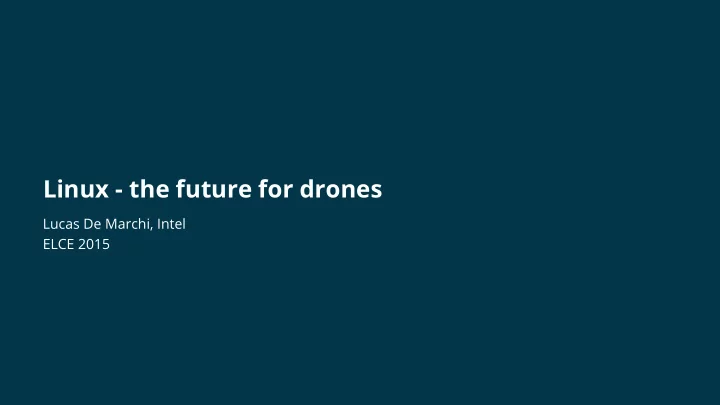

Linux - the future for drones Lucas De Marchi, Intel ELCE 2015
Who am I ▪ Software developer ▪ Contributed to several open source projects throughout the Linux stack ▪ Recently joined projects under the Dronecode ▪ Linux maintainer for Ardupilot
Agenda ▪ Dronecode ▪ Hardware evolution ▪ Software evolution ▪ Handling the complexity and scaling ▪ Future
Dronecode
“If you want to go quickly go alone, if you want to go far go together”
Dronecode ▪ 40+ members ▪ Composed of several projects, including 2 flight stacks ▪ Contributions to each of them increasing
Dronecode Ardupilot
Hardware evolution
Hardware evolution Ardupilot Pixhawk2 2015
Hardware evolution Ardupilot - Linux Boards It all started with a single board, with a specific set of sensors in a daughter board: BeagleBone Black + PXF cape
Hardware evolution Ardupilot - Linux Boards PXF 2014 Navio/Navio+ 2014 ▪ ▪ ErleBoard 2014 Raspilot 2015 ▪ ▪ BBBMini 2015 ErleBrain2* 2015 ▪ ▪ VR Brain 5 LX* 2015 ▪ Expansion boards for BeagleBone Expansion boards for Black Raspberry Pi * Not merged yet
Hardware evolution Ardupilot - Linux Boards Bebop MinnowBoard Max* ▪ ▪ Own HW and Linux stack Drone Lure with sensors ▪ ▪ * Not merged yet
Overview how a drone works
Hardware/software evolution 101 - How a drone actually works (simplified) Accelerometer RC GCS APP Motor UART / TCP / UDP Gyroscope CAN UART / . . . Motor PWM / I2C / I2C / SPI UART Barometer Flight stack ESC Motor Magnetometer Motor GPS ... ...
Hardware/software evolution 101 - How a drone actually works (simplified) Accelerometer RC GCS APP Motor UART / TCP / UDP Gyroscope CAN UART / . . . Motor PWM / I2C / I2C / SPI UART Barometer Flight stack ESC Motor Magnetometer Motor GPS ... ... Input Output
Hardware/software evolution 101 - How a drone actually works (simplified) Accelerometer RC GCS APP Motor UART / TCP / UDP Gyroscope Motor PWM / I2C / Flight stack I2C / SPI UART Barometer CAN Filter EFK PID ESC Motor Magnetometer Controllers ... Motor GPS ... ... Input Output
Software evolution
Software evolution Sensors ▪ From few samples per second to thousands ▪ Redundancy ▪ More complex sensors Lidar ▪ Optical Flow ▪ Depth cameras ▪ Computer vision ▪
Software evolution “Low-level” flight stack ▪ Increasing accuracy (hence complexity) of control algorithms E.g. the move to EKF for AHRS ▪
Software evolution Usages - pushing the complexity ▪ Photography ▪ Agriculture ▪ Survey / Mapping ▪ Inspection ▪ Deliveries ▪ Search and rescue
Software evolution Outcome ▪ Drones becoming smarter ▪ Intelligence inside vs outside ▪ Increased CPU and memory requirements ▪ Need to scale for more hardware platforms
Handling the complexity and scaling
Handling the complexity and scaling Boards in Ardupilot ▪ APM1 and APM2 are deprecated Not enough RAM, flash and CPU anymore ▪
Handling the complexity and scaling Sensors in Ardupilot ▪ Support for more sensors, different manufacturers ▪ Linux boards becoming first class citizens PX4-only features moving to common code ▪ Linux-only features starting to appear (existing ▪ infrastructure in Linux)
Handling the complexity and scaling When microcontrollers are not enough anymore ▪ Companion computer Move complex tasks to a separate Linux board ▪ Move flight stack to a separate microcontroller ▪ ▪ Single board Linux solution Both flight stack and other tasks on same board ▪
Handling the complexity and scaling When microcontrollers are not enough anymore ▪ Companion computer Move complex tasks to a separate Linux board ▪ Move flight stack to a separate microcontroller ▪ ▪ Single board Linux solution Both flight stack and other tasks on same board ▪ This is the solution taken for the Linux boards currently supported in Ardupilot
Handling the complexity and scaling Single board Linux solution ▪ Realtime ▪ Offload specific part(s) of the stack To separate microcontroller (even inside the SoC) ▪ To dedicated off-the-shelf hardware ▪
Handling the complexity and scaling Single board Linux solution 1. Move single-digit µs precision off the CPU: PWM output, RC decoding (PPM, SBUS, DSMX), tone generator, etc. 2. Follow guidelines for RT tasks in Linux 3. Have the necessary buses exposed 4. Cheers your new Linux-based flight stack
Future
Future Scaling for new boards ▪ Support for new boards (LIVE “DEMO”) ▪ Make adding new boards easier and scalable Runtime detection / configuration ▪ ▪ Different platforms ▪ Increased complexity
Future Scaling for new sensors Accelerometer RC GCS APP UART / TCP / UDP Gyroscope Flight stack I2C / SPI UART Barometer Filter EFK PID Magnetometer Controllers ... GPS ... Input
Future Scaling for new sensors Flight stack (Ardupilot) Controllers PID EKF Filters GPS Magnetometer Barometer Gyroscope Accelerometer
Future Scaling for new sensors Flight stack (Ardupilot) Userspace Controllers PID EKF Filters Sensor drivers Linux kernel Bus I2C_CHARDEV SPIDEV TTY abstraction Hardware GPS Magnetometer Barometer Gyroscope Accelerometer
Future Scaling for new sensors Flight stack (Ardupilot) Userspace Controllers PID EKF Filters Sensor HAL Sensor drivers IIO Linux kernel Sensor TTY abstraction Sensor drivers Hardware GPS Magnetometer Barometer Gyroscope Accelerometer
Future Scaling for new sensors Use kernel drivers (IIO subsystem) Pros: Cons: Several drivers already available ▪ Can't share driver with other platforms ▪ Share testing with other platforms ▪ (PX4 middleware / Nuttx) (Linux desktop, Android) Harder to prototype new drivers ▪ Reduce complexity on the flight stack ▪ Currently used sensors don't have ▪ Reduce overhead to communicate with ▪ kernel drivers or don't have the right sensor: flight stack access data stream interfaces Middle ground: support both for separate buses
Future aka dreams ▪ Linux boards to foster use of new algorithms ▪ New sensors ▪ Smarter autonomous drones
Wrap-up ▪ Drones growing in application and capabilities ▪ Linux provides scaling at HW and SW levels ▪ Sharing parts with other projects improves code quality and testability
Q&A Links: Dronecode: http://www.dronecode.org drones-discuss mailing list Ardupilot: http://ardupilot.com/ http://diydrones.com Contact: lucas.demarchi@intel.com Gitter Skype Slides: conference site IRC Mumble
Recommend
More recommend